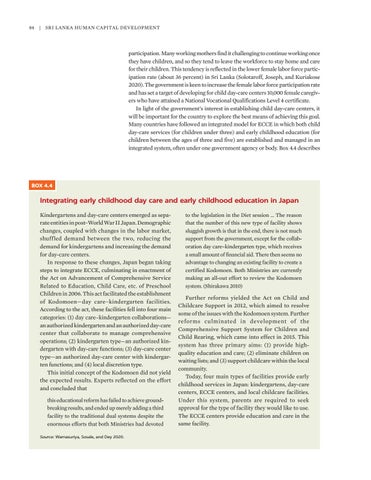84 | Sri Lanka Human Capital Development
participation. Many working mothers find it challenging to continue working once they have children, and so they tend to leave the workforce to stay home and care for their children. This tendency is reflected in the lower female labor force participation rate (about 36 percent) in Sri Lanka (Solotaroff, Joseph, and Kuriakose 2020). The government is keen to increase the female labor force participation rate and has set a target of developing for child day-care centers 10,000 female caregivers who have attained a National Vocational Qualifications Level 4 certificate. In light of the government’s interest in establishing child day-care centers, it will be important for the country to explore the best means of achieving this goal. Many countries have followed an integrated model for ECCE in which both child day-care services (for children under three) and early childhood education (for children between the ages of three and five) are established and managed in an integrated system, often under one government agency or body. Box 4.4 describes
BOX 4.4
Integrating early childhood day care and early childhood education in Japan Kindergartens and day-care centers emerged as separate entities in post–World War II Japan. Demographic changes, coupled with changes in the labor market, shuffled demand between the two, reducing the demand for kindergartens and increasing the demand for day-care centers. In response to these changes, Japan began taking steps to integrate ECCE, culminating in enactment of the Act on Advancement of Comprehensive Service Related to Education, Child Care, etc. of Preschool Children in 2006. This act facilitated the establishment of Kodomoen—day care–kindergarten facilities. According to the act, these facilities fell into four main categories: (1) day care–kindergarten collaborations— an authorized kindergarten and an authorized day-care center that collaborate to manage comprehensive operations; (2) kindergarten type—an authorized kindergarten with day-care functions; (3) day-care center type—an authorized day-care center with kindergarten functions; and (4) local discretion type. This initial concept of the Kodomoen did not yield the expected results. Experts reflected on the effort and concluded that this educational reform has failed to achieve groundbreaking results, and ended up merely adding a third facility to the traditional dual systems despite the enormous efforts that both Ministries had devoted Source: Warnasuriya, Sosale, and Dey 2020.
to the legislation in the Diet session … The reason that the number of this new type of facility shows sluggish growth is that in the end, there is not much support from the government, except for the collaboration day care–kindergarten type, which receives a small amount of financial aid. There then seems no advantage to changing an existing facility to create a certified Kodomoen. Both Ministries are currently making an all-out effort to review the Kodomoen system. (Shirakawa 2010)
Further reforms yielded the Act on Child and Childcare Support in 2012, which aimed to resolve some of the issues with the Kodomoen system. Further reforms culminated in development of the Comprehensive Support System for Children and Child Rearing, which came into effect in 2015. This system has three primary aims: (1) provide high- quality education and care; (2) eliminate children on waiting lists; and (3) support childcare within the local community. Today, four main types of facilities provide early childhood services in Japan: kindergartens, day-care centers, ECCE centers, and local childcare facilities. Under this system, parents are required to seek approval for the type of facility they would like to use. The ECCE centers provide education and care in the same facility.




